High-Throughput Liquid–Liquid Extraction in 96-Well Format: Parallel Artificial Liquid Membrane Extraction
LCGC Europe
Parallel artificial liquid membrane extraction (PALME) is a miniaturized version of liquid–liquid extraction (LLE) and is based on two 96-well plates in a sandwich-like configuration. With a very simple workflow, 96 samples can be processed simultaneously in PALME, providing analyte enrichment, highly efficient sample cleanup, and direct compatibility with liquid chromatography–mass spectrometry (LC–MS). The consumption of hazardous organic solvents is also almost eliminated using PALME as the sample preparation technique. This article summarizes current experiences with PALME, based on work both in a university laboratory and in an analytical services contract laboratory.
Photo Credit: plule_r/Shutterstock.com

Astrid Gjelstad1, Alf Terje Andresen2, Anders Dahlgren2, Thomas E. Gundersen2, and Stig Pedersen-Bjergaard1,31School of Pharmacy, University of Oslo, Oslo, Norway, 2VITAS, Oslo, Norway, 3Department of Pharmacy, Faculty of Health and Medical Sciences, University of Copenhagen, Copenhagen, Denmark
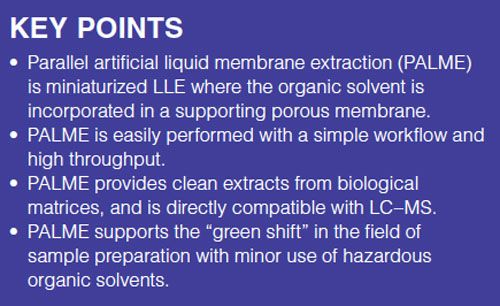
Parallel artificial liquid membrane extraction (PALME) is a miniaturized version of liquid–liquid extraction (LLE) and is based on two 96-well plates in a sandwich-like configuration. With a very simple workflow, 96 samples can be processed simultaneously in PALME, providing analyte enrichment, highly efficient sample cleanup, and direct compatibility with liquid chromatography–mass spectrometry (LC–MS). The consumption of hazardous organic solvents is also almost eliminated using PALME as the sample preparation technique. This article summarizes current experiences with PALME, based on work both in a university laboratory and in an analytical services contract laboratory.
In the past two decades significant interest has been devoted to miniaturization of liquid–liquid extraction (LLE). This was originally initiated by the development of singleâdrop microextraction (SDME) (1,2), where target analytes are extracted from an aqueous sample and into a small droplet of organic solvent suspended from the tip of a micro-syringe. After SDME, the droplet is retracted into the micro-syringe, and subsequently injected into a gas chromatography (GC) system. The justifications for the development of SDME were to (i) reduce the solvent consumption, (ii) increase the preconcentration, (iii) eliminate the need for evaporation, and (iv) improve the compatibility of the sample with miniaturized liquid chromatography (LC) systems. SDME can provide very high enrichment, efficient sample cleanup, and can be fully automated. Thus, many research papers have recently been published on SDME (3). Unfortunately, the droplet in SDME may be unstable when in contact with complicated sample matrices, and may be lost during extraction.
To circumvent this problem, hollow-fibre liquid-phase microextraction (HF-LPME) was proposed (4), where target analytes are extracted from aqueous sample, through a thin supported liquid membrane (SLM) immobilized in the pores in the wall of a porous hollow fibre, and into an acceptor solution located inside the lumen of the hollow fibre. This arrangement was found to be more stable because the acceptor solution was protected by the SLM comprising a water-immiscible organic solvent. Thus, HF-LPME is compatible with complicated biological and environmental samples (5,6). Similar to SDME, HF-LPME can provide very high enrichment, good sample cleanup, and the consumption of hazardous organic solvents is reduced to a minimum. Thus, HF-LPME has been used for a broad range of applications (5,6).
For future implementation of miniaturized liquid–liquid extraction into research and routine laboratories, the availability of robust commercial products for semi- or full automation in the 96-well format is necessary. To address this, the HF-LPME principle was recently transferred to 96-well plates using flat porous filters (membranes) for support of the SLMs. This concept used commercial 96-well filter plates originally intended for filtration, and was termed parallel artificial liquid membrane extraction (PALME) (7). While the first PALME experiments were performed in the university laboratory (School of Pharmacy, University of Oslo) (7–10), a collaboration with a contract analytical services laboratory (VITAS) was recently established to identify and address the critical factors for successful operation in laboratories with no previous PALME experience. This article summarizes the major experiences from this collaboration, and details earlier experiences with the extraction of basic and acidic drugs from human plasma (7,8,10). The article is focused on (i) the principle of PALME, (ii) typical performance data, and (iii) how to perform the extractions successfully from a practical point of view.
Principle of PALME
The setup and basic principle for PALME is illustrated in Figure 1(a) and (b), and the workflow is presented in Figure 2. The setup comprises a 96-well filter plate for housing the SLMs and the acceptor solutions (termed acceptor plate), a 96-well sample plate for housing the individual samples, and a sealing foil. The PALME procedure involves six different steps comprising a simple workflow that can be performed with multichannel pipettes or with a stepper or repetitive pipette. In PALME step #1, the individual samples are pipetted into separate wells in the sample plate. The volume of the biological matrix can be up to 200 µL. In PALME step #2, internal standard and buffer (or acid–base) is pipetted into the individual samples. In PALME step #3, the individual SLMs are pipetted onto the corresponding filters located in the acceptor plate. The SLM volume is typically 3–5 µL, and the SLM is instantly formed by pipetting the water-immiscible organic solvent directly onto the hydrophobic filter. Thus, the SLM is retained in the filter structure by capillary forces. In PALME step #4, the individual acceptor solutions are pipetted into the reservoir above the filters and SLMs in the acceptor plate. In PALME step #5, the sample plate and the acceptor plate are clamped, the acceptor plate is sealed with a sealing foil, and the entire “sandwich” is placed on an agitator. During agitation, target analytes in their uncharged state are extracted from each sample, through the corresponding SLM, and into the corresponding acceptor solution by passive diffusion as shown in Figure 1(b). In PALME step #6 (finished extraction), the individual acceptor solutions are removed and transferred for the final analysis. Typically, this can be performed directly by liquid chromatography–mass spectrometry (LC–MS), and so no evaporation is required.
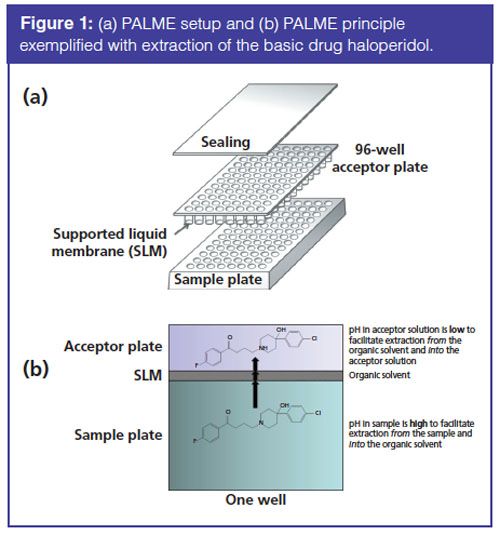
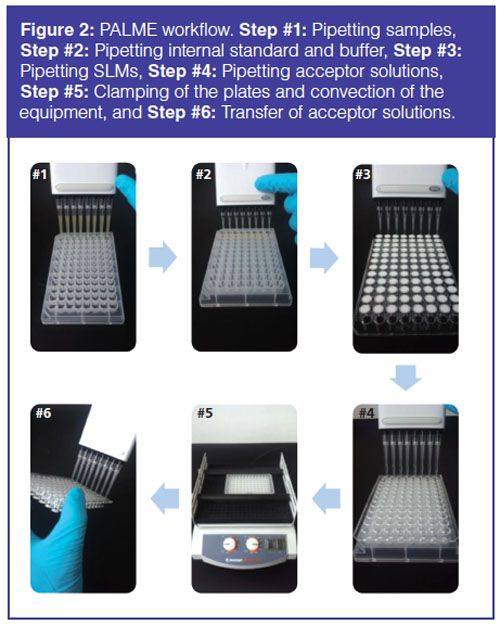
For extraction of basic analytes, the pH of the sample is raised above the pKa-value of the analytes to ensure full deprotonation. Thus, the basic analytes are extracted as uncharged species into the SLM (7). The acceptor solution is aqueous, and pH is adjusted below the pKa-value of the analytes to promote analyte ionization. The basic analyte is therefore prevented from re-entering the SLM, and is efficiently trapped in the acceptor solution. For extraction of acidic analytes, the pH-gradient across the SLM is reversed, under acidic conditions in the sample and neutral or alkaline conditions in the acceptor solution (8).
For both basic and acidic analytes with log P (octanol-water partition coefficient of the unionized specie) higher than 1.5–2.0, PALME works efficiently and high extraction recoveries can be expected. However, for more polar analytes, the transfer into the relatively nonpolar SLM is strongly reduced, and extraction recoveries are correspondingly low. For successful PALME of more polar analytes, an ionic carrier in the SLM is required to facilitate the mass transfer. One example of an efficient ionic carrier is di(ethylhexyl)phosphate (DEHP). DEHP is soluble in the SLM solvent, and transfers polar basic analytes into the SLM through ionic interactions at the sample or SLM interface (10).
Performance
PALME has been tested for the extraction of nonpolar basic drugs (7), polar basic drugs (10), and nonpolar acidic drugs (8) and reported in the international scientific literature. In addition, substantial experiences with drugs of abuse have been acquired during the initial testing of PALME. Extraction recoveries in PALME are related to the polarity of the analyte and to the extraction time. Initially, extraction recoveries increase rapidly with time, but after a certain period, PALME enters equilibrium conditions and there is no further gain in extraction recovery. Extraction recoveries at equilibrium are typically in the range from 30–100%, depending on the molecular structure of the analyte. For drug substances with log P above 2.0–2.5, the results at this point indicate that PALME provides exhaustive or close to exhaustive extraction. This is illustrated in Table 1 for seven basic model analytes in the log P range 3.01–5.01, and with values for polar surface area in the range 6.48–52.65. The chemical structures of the model analytes are shown in Figure 3. The data reported in Table 1 were acquired from pure water samples, but similar values have also been reported from human plasma. The extraction time to reach equilibrium is both analyte and sample dependent. From pure aqueous samples, equilibrium times can be in the range 15–45 min, but from biological fluids we have found that 60–120 min may be required for exhaustive extraction. The typical sample volume is 250 µL, and with 50 µL of acceptor solution, exhaustive PALME provides five times analyte preconcentration. Compared to HF-LPME, the preconcentration in PALME is relatively low. However, for most drug analysis applications utilizing highly sensitive LC–MS detection, high preconcentration is not required.
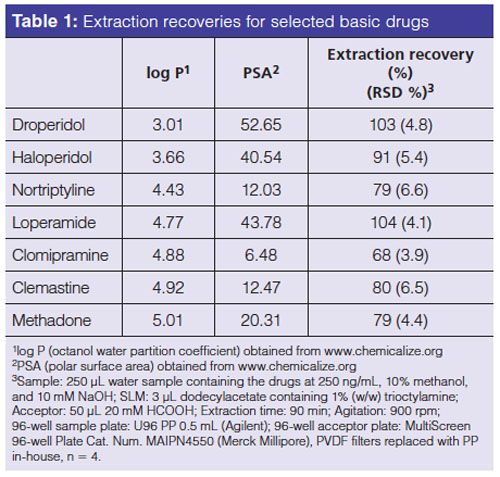
In PALME, the acceptor solution is separated from the sample by the SLM. Since the SLM comprises a relatively nonpolar organic solvent, sample matrix components, such as salts, polar organic substances, and biological macromolecules are prevented from entering the acceptor solution. Therefore, PALME provides excellent sample cleanup both when the system is tuned for basic drugs (7,10) and for acidic drugs (8). Recently, it was discovered that phospholipids present in human plasma samples are effectively discriminated by the SLM, and the acceptor solutions are free from phospholipids (9). This is very important in combination with electrospray ionization (ESI) LC–MS, which is prone to ion suppression or ion enhancement from residual plasma phospholipids.
As mentioned above, the typical SLM volume is 3–5 µL, and therefore the consumption of hazardous organic solvents is reduced to a minimum. Extraction of 96 different samples can be accomplished in 60–120 min, and the total volume of organic solvent used for the entire 96-well plate is only 290–480 µL. Thus, PALME has the potential to be a fully automated, high throughput, and green chemistry approach to liquid–liquid extraction in the future.
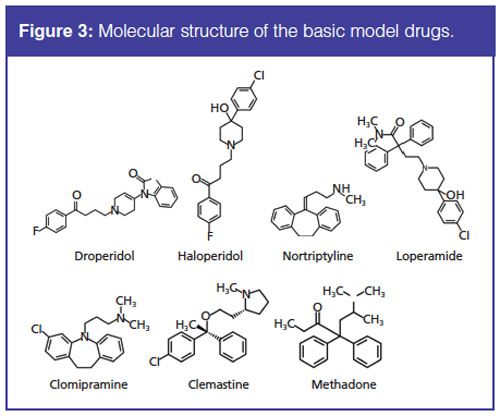
Practical Considerations
The PALME experiments initially performed in the university laboratory (7,8,10) were transferred to a contract analytical services laboratory and repeated there with similar results. Laboratories with no previous experience with PALME can therefore rapidly implement the workflow. The discussion below is the accumulated practical experiences from this transfer.
As discussed above, PALME step #1 involves pipetting the samples into the 96-well sample plate with a multichannel pipette. Commercially available 96-well sample plates of polypropylene with a 0.5-mL well volume are used as sample plates. With these plates, the sample volume is critical. The total sample volume (biological sample + internal standard solution + buffer, acid, base) should not be less than 200 µL (7). If so, an air gap between the sample solution and the SLM prevents efficient extraction. Between 200 µL and 250 µL, the sample volume is optimal. If the sample volume exceeds 300 µL, the sample well is overloaded. This results in uncontrolled sample volumes and potentially high standard deviations. No 96-well sample plates other than polypropylene with 0.5-mL wells have been tested, but several alternatives are commercially available with different volumes and will be tested in the future.
The pH value of the sample is important. As discussed previously, the analyte has to be in neutral form for efficient mass transfer into the SLM. For basic analytes, this relies on alkaline sample conditions. Dilute sodium hydroxide is used for adjusting the sample pH in PALME step #2, without further optimization. This is accomplished by mixing the human plasma samples 1:1 (v/v) with 40 mM sodium hydroxide directly in the sample wells (125 µL + 125 µL 20 mM NaOH), using a multichannel pipette. Alternatively, a stepper or repetitive pipette could be used for the pipetting. In forthcoming research, however, buffers should also be tested as alternatives for more soft and exact pH control. Under alkaline conditions, very nonpolar basic drugs may be prone to adsorption to the wall of the wells, and this can reduce analyte recoveries and prolong the equilibrium time. This was observed for clomipramine and clemastine in the experiments with the basic drugs reported in Table 1, using a 96-well sample plate of polypropylene. The addition of 10% methanol to the sample was found to improve the performance significantly, particularly for clomipramine and clemastine.
In PALME step #3, the organic solvent comprising the SLM is loaded into the polymeric filter in the bottom of the wells in the acceptor plate. This is performed with a multichannel pipette or a stepper or repetitive pipette. The SLM loading can be performed either from the sample side or from the acceptor side of each filter, with equal performance. The volume of organic solvent loaded into each filter is typically in the range 3–5 µL. Solvent volumes less than 3 µL are insufficient to cover the entire internal volume of the filter, and dry spots are visually observed on the filter. This should be avoided. Volumes exceeding 5 µL result in excessive organic solvent with poor immobilization. This should also be avoided. Based on experimental experience (data not shown), minor variations in the SLM volume in the range 3–5 µL from well to well do not affect the extraction performance. The organic solvent is rapidly immobilized by capillary forces, and each SLM is essentially ready for use within 5–10 s after loading. The SLMs are always used for extractions less than 30 min after loading. However, some solvents like dodecylacetate are stable for a long time after loading, while other solvents like n-dihexyl ether are more prone to swelling in the polymeric material and are stable for only a couple of hours.
Experiences with different organic solvents in PALME are currently limited. For nonpolar basic drugs, dodecylacetate, n-dihexyl ether, isopentyl benzene, and n-hexadecane have been tested as the SLM (7). The three latter solvents all appear to be highly efficient for nonpolar basic drugs, while n-hexadecane provided slightly lower extraction recoveries. For nonpolar acidic drugs, dihexyl ether, isopentyl benzene, and 2,2-dimethyl-1-propyl benzene are efficient candidates. The successful solvents are all water-immiscible, nonvolatile, with low viscosity and low polarity, but with some polar functionalities. The latter are important to effectively transfer target analytes based on a balance between polar and nonpolar molecular interactions. Knowledge on SLM solvents for PALME is limited, but dodecylacetate and dihexyl ether may be efficient generic solvents for basic drugs and acidic drugs, respectively. From literature, a broad range of organic solvents have been tested as SLM in HF-LPME (5,6), and these experiences can probably be transferred to PALME for rapid development of knowledge databases. However, solvent compatibility with the filter plate should be considered carefully.
Different filters as support for the SLM have been tested. 96-well acceptor plates are commercially available with polyvinylidene fluoride (PVDF) filters. However, for the drugs reported in Table 1, nonspecific binding was observed with dodecylacetate as the SLM, which resulted in poor linearity and repeatability. To some extent, the performance was improved by the addition of 1% trioctylamine to the SLM, but even better data were obtained when the PVDF filters were replaced with polypropylene (PP) as the SLM support (Table 1). Polypropylene has been used successfully in HF-LPME over the last 15 years, and also in the case of PALME, this material appears to be much less prone to nonspecific binding. Currently, and to the best of our knowledge, there are no 96-well filter plates commercially available with polypropylene membranes in appropriate dimensions. However, such plates may simplify future method development in PALME because polypropylene is less sensitive to nonspecific binding.
In PALME step #4, the acceptor solutions were pipetted into the individual acceptor wells in the 96-well acceptor plate. Again, a multichannel pipette or a stepper or repetitive pipette was used. During pipetting of acceptor solutions into the acceptor plate, the operator should be careful not to interrupt the filter and the SLM constituting the bottom of each acceptor well. For extraction of nonpolar basic drugs, 20 mM formic acid was used as acceptor solution (7), while 25 mM ammonia solution was used for nonpolar acidic drugs (8). Both acceptor solutions are highly compatible with LC–MS, and can be injected directly into the system. In most cases, 50 µL was used as the volume of the acceptor solutions. Volumes in the range 50–100 µL were considered optimal in terms of extraction recovery and liquid handling. Volumes less than 50 µL may be challenging to remove with pipettes after PALME, and are more sensitive to evaporative losses. Volumes exceeding 100 µL can be used, but such PALME conditions provide limited or no preconcentration of analytes.
In PALME step #5, the sample plate and the acceptor plate are clamped, and a sealing foil is located on the top. This “sandwich” system is then placed in an agitator, and the extraction process is initiated at the onset of agitation. Agitation with orbital movement was used, at an optimal agitation rate of 900 rpm. If the agitation rate is reduced, the extraction efficiency is decreased because of reduced convection in the samples. However, agitation rates above 900 rpm do not improve extraction performance and can put excessive stress on the system. As discussed above, equilibrium extraction times in PALME are typically 60–120 min from human plasma samples. The extraction time needs to be optimized by practical experiments. Investigation of PALME under nonequilibrium conditions should also be performed to test the reliability of data obtained after soft and rapid PALME operation.
After PALME, it is recommended to remove the acceptor solutions immediately from the acceptor plate. The reason for this is that the acceptor solutions are always in contact with the corresponding SLMs when located in the acceptor plate, and analytes may potentially be back-extracted into the SLM during storage in the acceptor plate. In manual work with PALME, the removal of the acceptor solutions is the most critical step in the PALME workflow. With 50-µL acceptor solution in each well, the height of each acceptor segment is only 2.5 mm. Simultaneous pipetting with a multichannel pipette without interruption of the filters and SLMs requires a high level of operator skill. However, to improve this manual step, the acceptor plate is always tilted 45° and the acceptor solutions are much easier to collect. After collecting the acceptor solutions, they are directly pipetted into corresponding micro inserts for the final LC–MS analysis. A PALME system with the samples located in the filter plate (top) and with the acceptor solutions located in the sample plate (bottom) is also examined. In this case, the sample plate containing the final acceptor solutions was sealed after PALME and transferred directly to the autosampler of the LC–MS instrument. The need for liquid handling after PALME was therefore eliminated. However, with the 96-well plates used up to date, extraction recoveries were lower in this configuration because of unfavourable convection conditions.
Future Development and Implementation
Based on initial experiences, PALME is an interesting concept for future sample preparation in busy laboratories. It is well suited for the pharmaceutical industry, for analytical services contract laboratories, and for hospital laboratories. PALME appears to be very efficient for the extraction of drug substances from small volumes of biological fluids, providing a high level of sample cleanup and a simple workflow. In the future, automation and development of generic methods for basic and acidic drugs will be explored, and hopefully “tailor-made” commercial products for PALME will emerge, eliminating issues related to nonspecific binding.
References
- H. Liu and P.K. Dasgupta, Anal. Chem.68, 1817 (1996).
- M.A. Jeannot and F.F. Cantwell, Anal. Chem.68, 2236 (1996).
- J.M. Kokosa, TrAC -Trend Anal. Chem.43, 2 (2013).
- S. Pedersen-Bjergaard and K.E. Rasmussen, Anal. Chem. 71, 2650 (1999).
- E. Carasek and J. Merib, Anal. Chim. Acta880, 8 (2015).
- A. Spietelun, Å. Marcinkowski, M. de la Guardia, and J. NamieÅnik, Talanta119, 34 (2014).
- A. Gjelstad, K.E. Rasmussen, M.P. Parmer, and S. PedersenâBjergaard, Bioanalysis5, 1377 (2013).
- M. Roldán-Pijuán, S. Pedersen-Bjergaard, and A. Gjelstad, Anal. Bioanal. Chem.407, 2811 (2015).
- K.S. Ask, T. Bardakci, M.P. Parmer, T.G. Halvorsen, E.L. Øiestad, S. Pedersen-Bjergaard, and A. Gjelstad, J. Pharmaceut. Biomed.129, 229 (2016).
- V. Pilar Ë ová, M. Sultani, K.S. Ask, L. Nováková, S. PedersenâBjergaard, and A. Gjelstad, J. Chromatogr. B In Press.
Astrid Gjelstad is currently an associate professor at the School of Pharmacy, University of Oslo, Norway.
Alf Terje Andresen is an analytical chemist who received his Ph.D. at the University of Oslo, Norway, in 1994. Since 2006 he has been a senior research scientist at Vitas Analytical Services Limited, in Oslo, Norway.
Anders Dahlgren is the CTO of Vitas Norway. He has over 25 years’ experience as an analytical chemist with the last 17 years spent at Vitas.
Thomas E. Gundersen is the Chief Scientific Officer and co-founder and CEO of the CRO Vitas Analytical Services Limited, Oslo, Norway.
Stig Pedersen-Bjergaard is a professor at the School of Pharmacy, University of Oslo, Norway, and a part-time professor at the Department of Pharmacy, University of Copenhagen, Denmark.
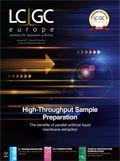
New Method Explored for the Detection of CECs in Crops Irrigated with Contaminated Water
April 30th 2025This new study presents a validated QuEChERS–LC-MS/MS method for detecting eight persistent, mobile, and toxic substances in escarole, tomatoes, and tomato leaves irrigated with contaminated water.
Accelerating Monoclonal Antibody Quality Control: The Role of LC–MS in Upstream Bioprocessing
This study highlights the promising potential of LC–MS as a powerful tool for mAb quality control within the context of upstream processing.
University of Tasmania Researchers Explore Haloacetic Acid Determiniation in Water with capLC–MS
April 29th 2025Haloacetic acid detection has become important when analyzing drinking and swimming pool water. University of Tasmania researchers have begun applying capillary liquid chromatography as a means of detecting these substances.
Prioritizing Non-Target Screening in LC–HRMS Environmental Sample Analysis
April 28th 2025When analyzing samples using liquid chromatography–high-resolution mass spectrometry, there are various ways the processes can be improved. Researchers created new methods for prioritizing these strategies.

.png&w=3840&q=75)

.png&w=3840&q=75)



.png&w=3840&q=75)



.png&w=3840&q=75)











